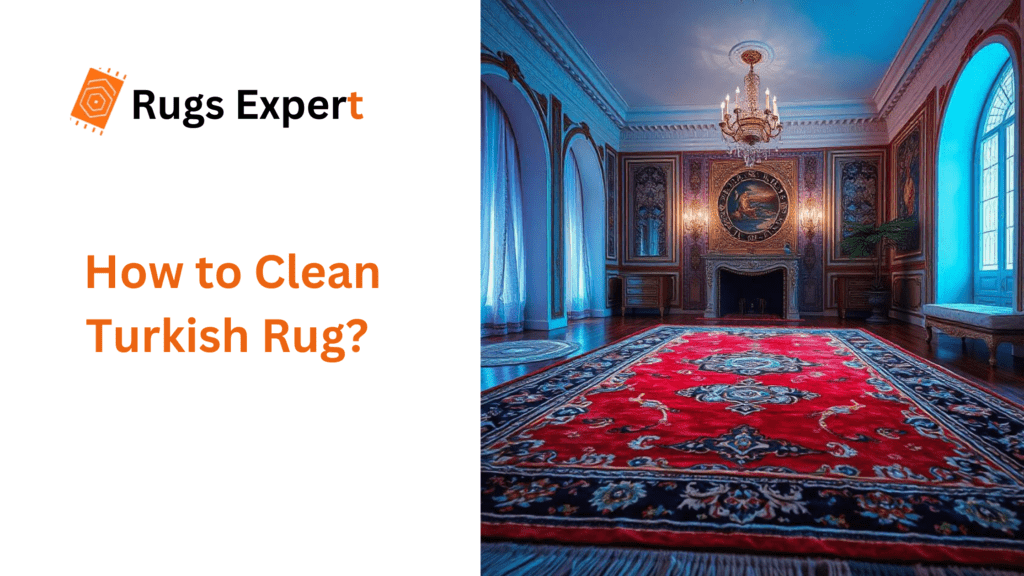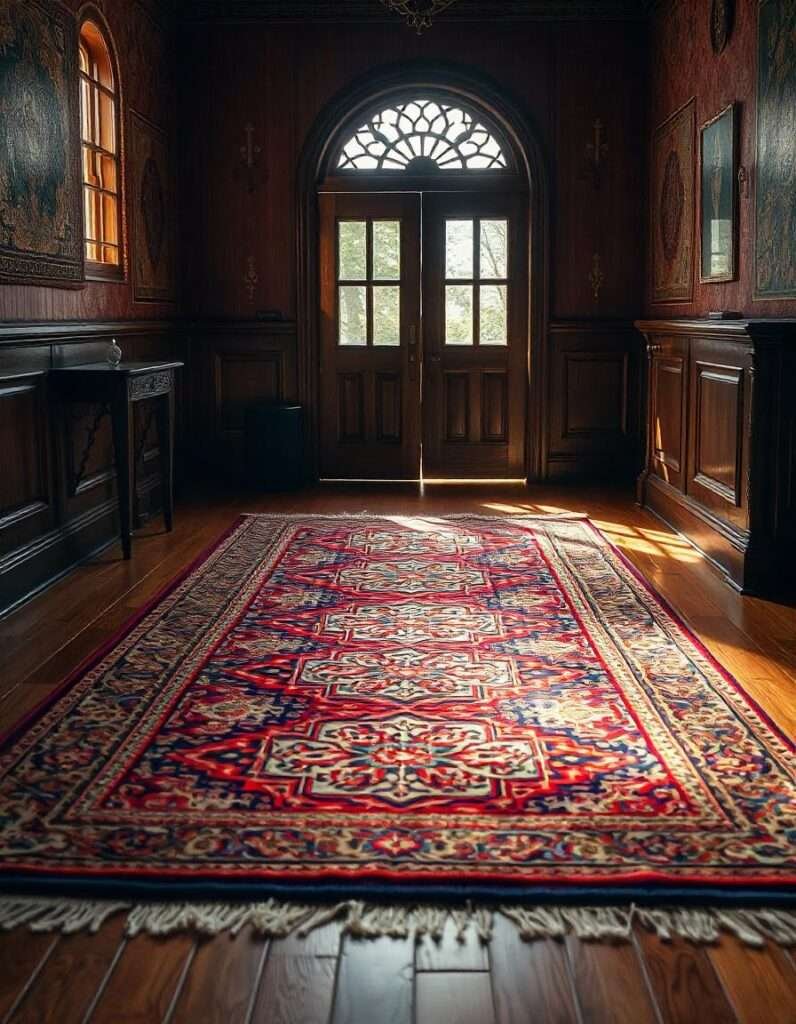
Have you ever looked at your beautiful Turkish rug and wondered how to keep it looking as stunning as the day you bought it? You’re not alone! Turkish rugs are not just floor coverings. They’re pieces of art that tell stories through their complicated and beautiful patterns and rich colors.
Whether you’ve inherited a family heirloom that’s been passed down through generations or you’ve recently fallen in love with a Turkish rug at a bazaar, knowing how to properly care for these textile treasures is absolutely important.
I’ve spent years learning the ins and outs of rug care, and let me tell you, there’s nothing quite like the satisfaction of seeing a well-maintained Turkish rug glowing in your living room.
In this guide, I’ll share everything I’ve learned about keeping these beautiful pieces in tip-top shape. Trust me, with the right knowledge and a little bit of effort, you can keep your Turkish rug looking elegant for years to come.
Understanding Turkish Rugs
Before we dive into cleaning techniques, let’s get to know these beautiful artworks a bit better. You know, understanding your rug is like getting to know a new friend the more you know, the better you can care for it.
Materials Matter

Turkish rugs are typically crafted from three main materials:
1: Wool
The most common material is known for its durability and natural stain resistance. Did you know that wool fibers can bend up to 20,000 times without breaking? That’s what makes wool rugs so long-lasting.
2: Silk
The luxury option, creating incredibly detailed designs and having a beautiful sheen. Silk rugs are the equivalents of fine jewelry in the rug world.
3: Cotton
Often used for the foundation of the rug, providing stability and preventing warping.
Some modern rugs might also incorporate synthetic fibers, but traditional Turkish rugs stick to these natural materials. Think of it as the difference between a home-cooked meal and fast food both have their place, but there’s something special about the traditional approach.
Types of Turkish Rugs
Let’s explore the main types you might see.
1: Kilim Rugs
These flat-woven beauties are like the marathoners of the rug world, lightweight but highly durable. Kilims are reversible and often feature geometric patterns that’ll make your inner interior designer jump for joy.
2: Oushak Rugs

Imagine stepping onto a cloud that’s what an Oushak rug feels like. Known for their silky wool and larger, more decorative patterns, these rugs are the gentle giants of the Turkish rug family.
3: Hereke Rugs
Now, these are the overachievers of the bunch. Hereke rugs are known for their incredibly fine knots. We’re talking up to 3,600 knots per square inch. That’s like having the resolution of a 4K TV in rug form.
Regular Maintenance
Alright, let’s roll up our sleeves and get into the nitty-gritty of keeping your rug looking great.
Daily Care Tips
Think of your Turkish rug as a high-maintenance friend who’s totally worth the effort. Here’s what you should do regularly:
1: Gentle Shaking
Weather permitting, take your rug outside for a gentle shake once a week. It’s like giving your rug a mini workout. Getting rid of loose dirt and keeping it fresh. Just be careful with older or more delicate rugs they might prefer a gentler approach.
2: Rotation Schedule
Mark your calendar! Every few months, give your rug a quarter turn. This ensures even wear, kind of like rotating the tires on your car. Trust me, your rug will thank you by aging gracefully and evenly.
3: Immediate Attention to Spills
Whenever a guest accidentally tips over their wine glass, and suddenly your heart’s racing faster than a Turkish bazaar negotiation. The key is to act fast. Blot (don’t rub!) the spill immediately with a clean and white cloth. Think of it as first aid for your rug.
Vacuum Cleaning Techniques

Now, let’s talk about everyone’s favorite chore said no one ever, vacuuming. But trust me, doing it right makes all the difference.
The Right Way to Vacuum
Here’s my tried-and-true method:
Start with the right equipment, use a vacuum without a beater bar. Those spinning brushes can be as damaging as a bull in a china shop.
Vacuum in the direction of the pile. It’s like petting a cat go with the grain, not against it. Be extra gentle with the fringes. They’re like the rug’s delicate eyebrows and handle with care.
Spot Cleaning
Accidents happen to the best of us. The key is knowing how to handle them like a pro.
Common Stains and Solutions
Below are some common types of stains and how to cure them immediately.
Water-Soluble Stains
For things like soda, wine, or coffee mix one teaspoon of mild dish soap with a cup of lukewarm water. Pat the stain gently with a white cloth dipped in the solution. Dry the place with a clean cloth.
Repeat if necessary, but remember patience is your friend here
Oil-Based Stains
Found a mysterious grease spot? Here’s what to do, sprinkle cornstarch or talcum powder on the stain. Let it sit for 24 hours (yes, really!). Now Vacuum it up. If the stain remains, You can call the professionals.
Deep Cleaning Methods
Here are two types of cleaning, professional cleaning and DIY Deep cleaning. Let’s explore them one by one:
Professional Cleaning
Sometimes, you need to call in the cavalry. Here’s when to consider professional cleaning:
- Every 3-5 years for normal use
- More frequently for high-traffic areas
- Immediately after any major spills or accidents
When choosing a professional cleaner, look for someone who is specialized in Oriental and Turkish rugs. The one who uses proper cleaning methods for your specific rug type and has good reviews. He also can provide a detailed explanation of their cleaning process.
Think of professional cleaners as spa therapists for your rug. They know exactly what treatments will work best.
DIY Deep Cleaning
Feeling brave? Let’s dive into how you can deep clean your rug at home. But remember, this is like attempting to make your grandmother’s secret recipe, proceed with care.
Cleaning Tools
Here’s your shopping list:
- Mild rug shampoo
- Soft-bristled brush
- Clean white towels
- Garden hose
- Rubber gloves
- Bucket
- Squeegee
Step-by-Step Guide
- Test First: Always do a patch test in an invisible area.
- Prepare the Area: Choose a clean, flat surface. If you’re working outdoors avoid direct sunlight. It’s as bad for your rug as it is for your skin.
- Pre-Treatment: Vacuum your rug completely and see if there are any stains.
- The Main Event: Mix your cleaning solution according to instructions and work in small sections. Use your soft brush in the direction of the pile. Be gentle because you’re bathing your rug not scrubbing pots and pans.
- Rinse: Rinse completely until the water runs clear. Your rug should be cleaner than a whistle.
Drying Process
This is crucial, proper drying prevents mold, mildew, and bad smell that nobody wants.
The Right Way to Dry
- Remove excess water first:
- Use a squeegee in the direction of the pile
- Roll the rug with clean towels, like making a giant rug burrito
- Flat drying is essential:
- Use a flat, clean surface
- Ensure good airflow (fans are your friends)
- Flip after some time for even drying
- Check for complete dryness:
- Feel for any damp spots
- Check both front and back
- When in doubt, give it more time
Special Considerations

Antique Rugs
If your rug could talk, it’d probably have some fascinating stories to tell. Antique rugs need extra care. Do not use water on them. Dry cleaning can be a good option for them. Handle them with more care because these are pieces of history.
Natural vs. Synthetic Fibers
Different fibers need different care, like how you wouldn’t wash your silk dress the same way as your gym clothes.
Wool Rugs
Wool rugs are naturally stain-resistant and can shrink if soaked. We will suggest you not to use hot water and harsh chemicals on them.
Silk Rugs
Silk rugs are so delicate so professional cleaning is good for them. Avoid your silk rug from direct sunlight as well.
Cotton Elements
Rugs made of cotton are more tolerant of water cleaning. But they can be shrunk if not handled properly. They are usually found in the rug’s foundation.
Storage Tips
Sometimes you need to store your rug. Here’s how to do it right:
1: Clean First
Never store a dirty rug. It’s like going to bed without brushing your teeth, but worse.
2: Pest Protection
You can use cedar blocks or moth-repellent and avoid mothballs. They’re as outdated as dial-up internet.
3: Rolling vs. Folding
Always roll your rug. Folding can create permanent creases, think of it like folding a painting canvas.
4: Proper Materials
Use breathable fabric for wrapping. Do not use plastic because your rug needs to breathe.
5: Location, Location, Location
Always choose a cool dry place. Avoid basements and attics. Elevate off the floor if possible.
Maintenance Schedule
Let’s break it down into a manageable routine:
| Daily | Weekly | Monthly | Seasonally | Annually |
| Remove surface dirt | Thorough vacuuming | Rotation for even wear | Deep cleaning assessment | Professional inspection |
| Rotate rugs in direct sunlight | Check for any new stains or damage | More detailed inspection | Pest prevention check | Documentation of any changes or damage |
Conclusion
We’ve covered a lot of ground, haven’t we? Taking care of a Turkish rug might seem like a lot of work but trust me, it’s worth every bit of effort. These aren’t just rugs; they’re stories woven into the fabric, art you can walk on. And with proper care, they’ll be around to delight future generations.
Remember every Turkish rug is unique just like every home and family it belongs to. Use these guidelines as your roadmap. But don’t be afraid to adjust based on your specific situation. The key is regular, gentle care and quickly addressing any issues that arise.
As we say in the rug world, “A well-maintained rug is a happy rug!” Okay, maybe nobody actually says that, but they should. Your Turkish rug is more than just a floor covering. It’s a piece of history, art, and craftsmanship all rolled into one beautiful package.
Treat it right and it’ll bring warmth, beauty, and character to your home for years to come.
